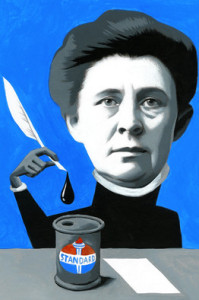WSJ Historically Speaking: A Brief History of Media Muckraking
Forty years ago this week, the House Judiciary Committee voted to impeach President Richard Nixon. Never comfortable with the media, Nixon made no attempt to hide his true feelings about reporters (especially Bob Woodward and Carl Bernstein of the Washington Post) or where he thought the blame belonged for his downfall: “It’s the responsibility of the media to look at the president with a microscope, but they go too far when they use a proctoscope.”
Many U.S. presidents have shared Nixon’s exasperation with the press. Theodore Roosevelt coined the term “muckraker” during a speech in 1906. He compared investigative reporters to the narrow-minded figure in John Bunyan’s 17th-century religious fable, “The Pilgrim’s Progress”: the “man that could look no way but downwards, with a muckrake in his hand.”
The idea of reform-minded journalism existed long before Roosevelt complained about its alleged excesses. The two fathers of modern journalism, Richard Steele and Joseph Addison, started the Spectator in 1711 with the explicit aim of informing, educating, entertaining and reforming British society. The 10th issue had “Mr. Spectator” declare: “I shall endeavor to enliven Morality with Wit, and to temper Wit with Morality.”
The British press started to flex its political muscles in the 1770s, when the gadfly John Wilkes fought the government for the right to publish parliamentary debates. Wilkes’s campaign led to mass marches, riots and even a stint in prison for him. Nevertheless, he succeeded in establishing the freedom of the press to report on politics. Emboldened, the major London newspapers began to regard themselves as the “fourth estate”—a power in their own right. The Times of London became known as “the Thunderer” after one of its editorials began: “We thundered out the other day an article on social and political reform.”
When the world’s first war correspondent, William Howard Russell, came to the U.S. to report on the Civil War, his brand of nonpartisan, investigative journalism irritated many Americans. But in 1871, a mere 10 years later, the U.S. press was going after the corrupt and the vicious with unbridled confidence. Among their first targets were William “Boss” Tweed of Tammany Hall and the graft-taking congressmen in the Credit Mobilier railroad scandal.
The Progressive Era, from the 1890s to the 1920s, was a golden age for crusading journalism, including The Wall Street Journal’s 1922 revelation of bribery and collusion among the Harding administration and California oil barons. The first undercover reporter seems to have been Elizabeth Jane Cochrane, writing under the pseudonym Nellie Bly.
In 1887, Bly feigned madness to have herself committed to the women’s insane asylum on New York’s Blackwell’s Island. After 10 harrowing days in which Bly witnessed incredible scenes of torture, deprivation and psychological cruelty toward the inmates, some of whom weren’t mentally ill at all, a lawyer from Bly’s paper, the New York World, secured her release. Bly’s subsequent report helped to bring sweeping changes to the asylum.
Fifteen years later, Ida Tarbell began her groundbreaking exposé for McClure’s magazine of John D. Rockefeller’s Standard Oil monopoly. Tarbell’s 1904 book, “The History of the Standard Oil Company,” helped result in the company being broken up under the 1911 Sherman Anti-Trust Act. A second Ida, the African-American journalist Ida B. Wells-Barnett, risked her life to bring the horror of Southern lynch mobs to the world’s attention. She became a founding member of the NAACP in 1909.
The muckrakers haven’t always received their due from history. But as Joseph Addison joked, being relegated to yesterday’s news is an occupational hazard: “We are always doing something for posterity, but I would fain see posterity do something for us.”

